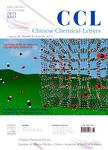Species,engineering and characterizations of defects in TiO2-basedphotocatalyst
Species, engineering and characterizations of defects in TiO_2-based photocatalyst作者机构:State Key Laboratory of Catalysis 2011-iChEM Dalian National Laboratory for Clean Energy Dalian Institute of Chemical Physics Dalian 116023 China University of Chinese Academy of Sciences Beijing 100049 China National & Local Joint Engineering Research Center for Applied Technology of Hybrid Nanomaterials Collaborative Innovation Center of Nano FunctionalMaterials and Applications of Henan Province Henan University Kaifeng 475004 China
出 版 物:《Chinese Chemical Letters》 (中国化学快报(英文版))
年 卷 期:2018年第29卷第5期
页 面:671-680页
核心收录:
学科分类:081704[工学-应用化学] 081705[工学-工业催化] 07[理学] 070304[理学-物理化学(含∶化学物理)] 08[工学] 0817[工学-化学工程与技术] 0703[理学-化学]
基 金:financially supported by the Basic Research Program of China(973 Program,No.2014CB239403) the National Natural Science Foundation of China(Nos.21633009,21373210,21522306) the priority support from the“Hundred Talents Program”of Chinese Academy of Sciences
主 题:Titanium dioxide Defect engineering Photocatalysis Water splitting Environmental purification
摘 要:Light absorption, charge separation and surface reaction are considered as the main processes ofphotocatalysis on one semiconductor, and all of them are demonstrated to be related to the defect statesof photocatalysts. This paper will choose Ti02 as model photocatalyst to introduce some basic conceptsand strategies related to defects and methods developed to characterize defects in the past ***, such strategies as hydrogenation and metal/nonmetal doping intoTi02 will be introduced toextend utilization of solar spectrum and/or to provide active sites. On the contrary, the unfavorable effectof defects such as acting as recombination centers of photogenerated carriers will also be *** typical methods to characterize the properties of defects are summarized, which contain electronparamagnetic resonance (EPR), photoluminescence technique (PL), positron annihilation spectroscopy(PAS), and so on. We do hope that this review will make a revealing effect on understanding to thefunctions of defects as well as construction of efficient photocatalytic systems in the future.



